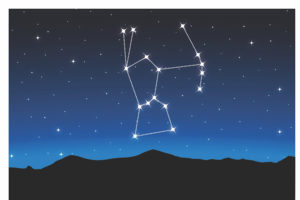Stargazing in winter is not for the faint of heart. Who would choose to stand out in the freezing cold for hours, staring up at the sky for a glimpse of some tiny wonder of the universe? Amateur astronomers, that’s who. But why in winter? Why not take a break for the season, polish one’s telescope, reorganize one’s eyepiece collection, then head out again in spring like a normal person?
Because the best viewing conditions typically occur during winter. When it’s not snowing, the sky is often clear and free of upper atmosphere turbulence, which can obscure viewing during other times of the year, especially summer. Let’s bundle up and venture outside to enjoy one of the gifts of those clear winter skies: the different colors of the stars.
At first glance stars can appear the same dim blue-white. But if you look a little closer, and if conditions are clear and still enough, you’ll discover a range of colors and brightness. The colors will be subtle for sure, but as with all things in the sky, the longer you look, the more you’ll see. We’ll use the constellation Orion as our guide to a few of these stars, since it’s a constellation that most people know. If you don’t know it, or need a refresher (no shame in that), the internet can help. Search for orion constellation.
Once you have a clear mental image of Orion, head outside after dark. Find an area with a clear view to the south. Then give your eyes time to adapt to the dark; you won’t see much color or very many stars when you first step outside. Try to avoid any outdoor lights or car headlights in your line of sight — they’ll ruin your night vision, and it can take several (very cold) minutes to recover it.
When you’re ready, look for Orion. His belt is the easiest thing to find: look for three stars close together in a row. Interpretations of Orion vary; traditional sources depict him holding a club up high in one hand, and a lion pelt in the other.
Two stars represent Orion’s knees, below his belt. His left knee (on the right from our point of view) is blue-white Rigel. Now move your eyes up to his right shoulder (on our left). The star there is red Betelgeuse. These two stars are close enough together that you can easily shift your gaze from one to the other; give it some time, and you’ll begin to see how different their colors really are.
Now let’s move beyond Orion. Start with the lion pelt that he’s holding, then move your eyes a little up (north), until you encounter the orange star Aldebaran, in the constellation Taurus. Now return to Orion and his belt. Trace a line from his belt down and to the left (southeast), until you encounter a very bright star. That’s white Sirius in the constellation Canis Major, one of the brightest objects in the night sky.
Ready for one more? Retrace your steps from Orion to Aldebaran, then keep going up (north) until you’re looking nearly straight up. Look for gold Capella, in the constellation Auriga.
White, blue-white, orange, gold, and red — the stars are like a treasure chest of gems. For professional astronomers, these colors reveal much about a star’s chemical composition, age, size, and surface temperature. But for us, let’s just enjoy the view. Clear skies!

